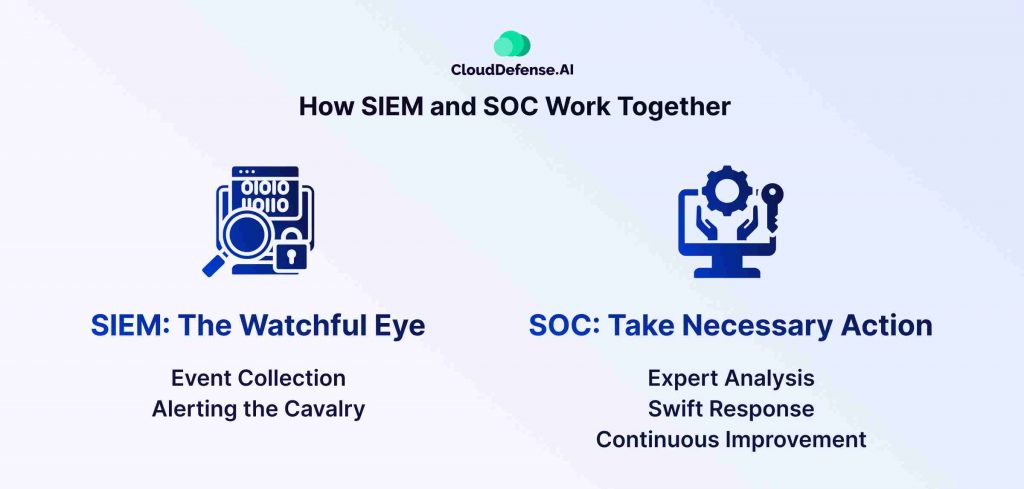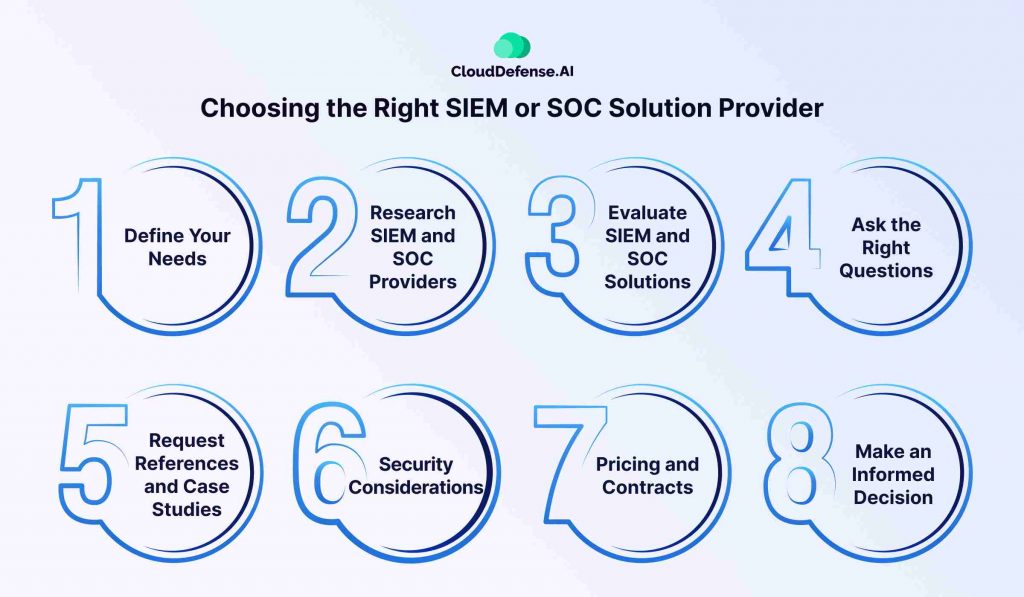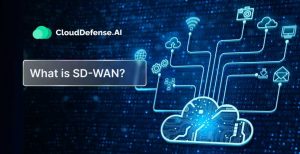Business face thousands of cyber threats every day, but do you know what’s working behind the scenes to keep them safe? Here’s where SOC and SIEM step in—two critical components in the cybersecurity framework. But here’s the twist: they’re not interchangeable.
While one is a team and the other is a tool, their synergy defines whether you catch the attack in time or pick up the pieces afterward. So, how do they differ? Which one matters more to your organization? Let’s get into a detailed exploration of SIEM vs SOC in this article.
What is an SIEM Solution?
A SIEM (Security Information and Event Management) solution collects and analyzes security data from across your network to help identify threats in real-time. It’s a tool that keeps your organization aware of potential risks before they escalate.
What SIEM does:
- Collects log data from various sources across your IT infrastructure.
- Analyzes patterns and flags abnormal activity.
- Correlates events to highlight potential security threats.
- Provides real-time monitoring to detect and respond to attacks quickly.
- Generates alerts based on specific conditions or thresholds.
At its core, SIEM is about giving you visibility into your security posture, making sure you don’t miss anything that could put your organization at risk. More than just about data collection, it’s about turning that data into something actionable. Without SIEM, you’re blind to potential threats.
What is a SOC Solution?
A SOC (Security Operations Center) is a team of experts who monitor, detect, and respond to security threats in real-time. Unlike SIEM, which is a tool, SOC is a dedicated operation focused on securing your network 24/7. It’s your cybersecurity surveillance unit, constantly on the lookout.
What a SOC does:
- Monitors security data across your network in real time.
- Analyzes alerts from tools like SIEM to detect potential threats.
- Responds immediately to incidents, minimizing damage.
- Coordinates with other teams to ensure continuous security improvement.
- Ensures compliance with regulatory standards and internal policies.
A SOC is more than just monitoring—it’s proactive defense. Without it, even the best tools like SIEM won’t be effective if there’s no team actively responding to threats. The human factor is critical.
How SIEM and SOC Work Together

You can’t rely on just one. SIEM alone won’t protect you, and SOC by itself can only do so much without the right data. Together, they form a system that can actually detect, understand, and respond to threats in real time.
SIEM is the first step. It pulls in everything: logs, events, alerts from firewalls, servers, endpoints—anything that’s happening in your network. It’s constantly analyzing this data for anomalies. But here’s the catch: SIEM can detect a problem, but it can’t decide if it’s a real threat. That’s where the SOC comes in.
SOC is your reaction force. When SIEM flags something, the SOC team is the one who investigates, analyzes, and then takes action. Without this, the alerts are just data points. What happens next? That’s the critical piece. SIEM provides visibility. SOC provides the muscle.
Think about it this way: SIEM gives you a map, but SOC is the team that knows how to read that map and follow it. When SIEM detects a threat, the SOC team doesn’t just look at the data—they dig into it, understand it, and act before the threat grows into something more serious.
- SIEM collects the noise: Logs, alerts, activities—anything that could hint at a threat.
- SOC decides what matters: SOC analysts separate the noise from the real threats and act on them.
- SIEM sees the patterns: It finds outliers and sends out alerts.
- SOC makes sense of the patterns: SOC experts review those patterns and respond—isolating infected systems, applying patches, improving defenses.
Together, they ensure nothing slips through the cracks. A threat might look like an anomaly on its own, but SIEM and SOC working together can put the pieces together to expose real risks. You need both—SIEM to collect the data and SOC to act on it. Without one, you’re flying blind.
SIEM vs SOC: Key Differences
At first glance, SIEM and SOC might seem like the same thing. But they’re not. One is a tool, the other is a team. Both are essential, but they serve entirely different roles in your security strategy.
SIEM is a technology. It’s a system that collects and analyzes data from across your network. Think of it as a filter—it pulls in vast amounts of information, looks for anomalies, and alerts you when something is off.
On the other hand, a SOC is a team of experts, people who use the data collected by tools like SIEM to make decisions and take action. They’re the ones who investigate alerts, respond to threats, and continuously improve your security posture.
Here’s how they break down:
SIEM (Tool):
- Collects and analyzes data.
- Detects potential threats.
- Alerts the team when something’s wrong.
- Doesn’t take action—it just provides insights.
SOC (Team):
- Uses data from SIEM and other sources to investigate and respond to threats.
- Actively manages incidents and mitigates damage.
- Continuously adapts security strategies.
- Takes action based on the information it gets.
Here’s a summary for your easy understanding:
| Parameter | SIEM | SOC |
| Type | Software Tool | Team of Security Professionals & Processes |
| Focus | Data Collection, Analysis, and Alerting | Threat Detection & Response, Investigation, and Improvement |
| Functionality | Centralizes security data, identifies suspicious patterns, sends alerts | Analyzes data from SIEM and other tools, investigates threats, takes corrective actions |
| Human Intervention | Limited (Requires configuration and interpretation of alerts) | High (Security analysts play a central role) |
| Expertise Required | Security knowledge for configuration and analysis | Diverse security expertise in threat detection, response, and forensics |
| Cost | Software licensing and maintenance fees | Salaries for security personnel, tools, and infrastructure |
| Scalability | Scalable based on data volume and processing power | Requires additional personnel and resources for larger organizations |
| Example | Acts like a security analyst constantly monitoring logs and events | Acts like a central command center coordinating security operations |
Choosing Between SIEM and SOC: What’s Right for Your Business?
Deciding between a SIEM or a SOC solution depends on your organization’s unique needs, risk factors, and security maturity. Here’s a breakdown to help you make the right choice.
SIEM Might Be Right for You If:
- You’re working with a limited security budget.
- Your IT team has basic security expertise and can handle SIEM setup and analysis.
- Your organization is smaller or handles less sensitive data, lowering the risk of major security threats.
- You primarily need a tool for centralized log management and basic threat detection.
- You have the internal capacity to configure and manage alerts, but need a system to automate data collection.
- You’re more focused on compliance than active threat hunting.
SOC Might Be Right for You If:
- Your business is highly regulated or deals with sensitive data that could lead to significant risks or penalties if breached.
- You lack the in-house expertise to handle complex security incidents, investigations, or advanced threat detection.
- Your business demands 24/7 security monitoring, rapid detection, and response to emerging threats.
- You need a proactive, hands-on security team to investigate, analyze, and respond to incidents rather than just alerting you to potential issues.
- You face frequent, sophisticated cyber threats that need immediate response to minimize impact.
- Your security needs are evolving rapidly, and you need a team that can adapt quickly to new attack vectors.
Consider a Hybrid Approach:
An ideal scenario often involves a combination of SIEM and SOC. You can leverage a SIEM for data collection and analysis, while outsourcing SOC functions to a Managed Security Service Provider (MSSP). This offers the benefits of both without the burden of building and maintaining a full-fledged in-house SOC team.
Here are some more factors to consider:
- The size and complexity of your IT infrastructure: A larger and more complex network necessitates a more robust security solution.
- The volume and type of data you handle: Organizations handling sensitive data like financial records or healthcare information require a higher level of security.
- Compliance requirements: Certain regulations may mandate specific security controls, potentially influencing your choice.
Ultimately, the best approach is to conduct a thorough security risk assessment to understand your organization’s vulnerabilities and tailor your security strategy accordingly.
Choosing the Right SIEM or SOC Solution Provider: A Guide

Choosing the right SIEM or SOC solution provider is crucial for bolstering your organization’s cybersecurity posture. Here’s a roadmap to guide you through the selection process:
1. Define Your Needs:
- Conduct a security risk assessment to identify vulnerabilities and threats specific to your industry and data.
- Determine your desired level of security – basic threat detection or advanced 24/7 monitoring.
- Evaluate your budget and internal security expertise.
- Consider compliance requirements and how a SIEM or SOC can help you meet them.
2. Research SIEM and SOC Providers:
- Shortlist vendors based on their reputation, experience in your industry, and product/service offerings.
- Look for providers with a proven track record of successful deployments.
- Research their expertise in threat intelligence, incident response, and security best practices.
3. Evaluate SIEM and SOC Solutions:
- Request demos to understand the functionality and user interface of the SIEM platform.
- Inquire about the SOC team’s composition, expertise, and threat hunting capabilities.
- Ensure the solution integrates with your existing security infrastructure.
- Consider scalability – can the solution accommodate future growth in data volume?
4. Ask the Right Questions:
- How does the SIEM or SOC solution address your specific security needs?
- What data sources can the SIEM integrate with?
- What threat intelligence feeds does the SOC utilize?
- How does the provider handle false positives and ensure timely incident response?
- What security certifications does the provider hold (e.g., SOC 2)?
5. Request References and Case Studies:
- Contact existing customers of the SIEM or SOC provider to get firsthand insights.
- Review case studies that showcase the provider’s success in resolving security incidents.
6. Security Considerations:
- Evaluate the provider’s data security practices and compliance with data privacy regulations.
- Inquire about their disaster recovery plan and business continuity measures.
7. Pricing and Contracts:
- Obtain transparent pricing quotes for the SIEM software, maintenance, or SOC services.
- Review the contract terms carefully, including service level agreements (SLAs) for uptime and response times.
8. Make an Informed Decision:
- Don’t solely focus on cost; consider the value proposition and long-term benefits of the solution.
- Choose a provider that fosters a collaborative partnership and offers ongoing support.
The Synergy of SIEM and CloudDefense.AI
Even the most powerful SIEM can be overwhelmed by the sheer volume and complexity of security data. This is where CloudDefense.AI steps in, acting as a powerful force multiplier for your SIEM solution. By integrating CloudDefense.AI with SIEM tools like Azure Sentinel, you can unlock a new level of security effectiveness and streamline your threat detection capabilities.
Here’s how CloudDefense.AI empowers your SIEM:
- Deeper Threat Visibility
- Faster & More Accurate Detection
- Reduced Response Times
- Improved Security Efficiency
Don’t settle for just seeing threats – take action against them. Book a demo today and discover how our solution can supercharge your SIEM and elevate your organization’s security posture from reactive to proactive.







